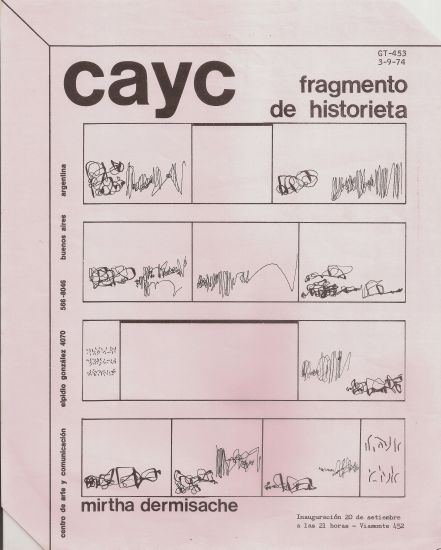
EDITIONS
At a certain point in her career, Mirtha Dermisache begins to produce editions of her works by releasing multiples from original pieces, thus entering, not only in a territory explored by other contemporary artists close colleagues to Mirtha, perhaps also responding to a certain ‘epoque spirit’ in which the reproducibility of the work of art went viral, and furthermore, supported by a conviction of Mirtha to facilitate greater access to creative production, and that the work of art extends its process vital, in life itself.
We share fragments of the text by Florent Fajole, one of the editors who accompanied Mirtha on numerous projects.
Mirtha Dermisache: The Otherness of the Writings
[…] In a key article published in 1970, Edgardo Cozarinsky writes about Jorge Romero Brest connecting her with the Paidós publishing house, which offered to publish a selection of writings from the first book dating from 1967 in the form of a portfolio, as is done for engravings. She refused because it was a book and because it should be edited as such and in its entirety. While this attempted matchmaking failed, new opportunities presented themselves at the invitation of Jorge Glusberg, who had just created the Centro de Arte y Comunicación (CAyC).
[…] Therefore, it is logical that the work would take on an editorial dimension. In this way, Mirtha Dermisache is a pioneering artist in the field of artists’ publications in Latin America, along with Edgardo-Antonio Vigo, Carlos Ginzburg, Ulises Carrión, the brothers Augusto and Haroldo de Campos, Julio Plaza, Décio Pignatari or even Wlademir Dias-Pino and Álvaro de Sá; and maybe even more than them since she designed her work as a whole from this perspective
[…] The first publication was printed on the occasion of the exhibition, Arte de Sistemas, at the Museo de Arte Moderno de Buenos Aires in 1971. It was one of the many Cartas produced the previous year. In 1972, on the occasion of Arte de Sistemas II, more than a thousand copies of Diario N. 1, Año 1 came out; long considered to be an abstract of Mirtha Dermisache’s work. Through its structure, the journal is particularly well-suited to its purpose since the division of the space in the form of articles and sections and their organization in columns or in boxes allows for the visualization of independent graphic developments while playing with a variety of heights, widths, rhythms and intensities.
[…] Next to come was Libro n° 1, 1969, also published by CAyC on the occasion of the Kunstsystemen in Latijns-Amerika exhibit at the Internationaal Cultureel Centrum in Antwerp in 1974 and the meeting with Guy Schraenen, who published the third edition of Diario, Cahier n° 1 in 1975, 4 Cartes postales in 1978, and a few other works (specifically in issue no. 1 of the magazine Axe).
[…] Thus, in 2004, I suggested that Mirtha Dermisache create the first “publishing installation” (“dispositif éditorial”) made up of twelve chairs and ten tables on which an offset printing of 400 copies of 9 Newsletters & 1 Reportaje was placed. The public was invited to experience this reading and to make its own publishing selection in the body itself of the installation. This suggestion was the forerunner of the decision, in 2010, to use alternative photographic processes in order to generate variants of one single work and to update it by creating new forms. For the publication of Texto, 1974, there were 24 of these variants divided into eight copies; they will next serve as a matrix for the production of a new rendering, a publication of 500 copies. These few examples suffice to give the scale and the meaning of the publishing dimension in Mirtha Dermisache’s work. Her purpose has never been to give a definitive form to the writings, the objects or the arrangements that support them, but rather to bring the reader’s focus and expression to the heart of this process.